| Columns Retired Columns & Blogs |
That is a very attractive piece of gear, a bit of vintage Sansui.
When I received the sample of the Moonriver 404 Reference that Jason Victor Serinus had auditioned, serial number DK201002153RE, it rattled when I unpacked it. I removed the top cover and saw that the amplifier had incurred damage during its transcontinental journey. The heavy toroidal power transformer is mounted on one side of the large printed circuit board that occupies almost all the amplifier's internal space, with two aluminum straps connecting the board to the central internal heatsink to provide the necessary support. The box must have been dropped on its top during the journey, as the two aluminum straps had fractured, with one loose inside the chassis. When I connected the amplifier to my Audio Precision SYS2722 system (see the January 2008 "As We See It"), the left channel was dead, though I was able to perform a complete set of tests on the right channel using the line-level inputs.
I let Editor Jim Austin and Moonriver's US distributor, Philip O'Hanlon of On a Higher Note, know about the situation. O'Hanlon told me that there would be a running change in production to provide more support for the transformer, and he arranged for Moonriver to ship a second sample to me directly from Sweden.
This sample, serial number DK201120164RE, arrived without shipping damage, and I resumed testing. Although the internal heatsink doesn't look substantial, it is connected to the bottom panel with thermally conductive grease so that the entire chassis can dissipate heat. I preconditioned the amplifier by following the IHF's recommendation of operating it at one-third the specified power into 8 ohms for an hour. At the end of that time, the temperature of the chassis was 100.1°F (37.8°C). The 404 Reference has sufficient heatsink capacity for its rated power.
I looked first at the new sample's behavior via its line inputs. The maximum gain at the loudspeaker outputs was 46dB, which is a little higher than usual for an integrated amplifier. At the preamplifier output, the maximum gain measured 16dB. The 404 Reference preserved absolute polarity (ie, was noninverting) at both its loudspeaker and preamplifier outputs.
The 404 Reference's line input impedance was an appropriately high 24k ohms at 20Hz and 1kHz, dropping to a sufficiently high 17.1k ohms at 20kHz. The manual says that the preamplifier output impedance is "a few ohms." I measured 96 ohms at high and middle frequencies and a higher 1426 ohms at the bottom of the audioband. However, I had problems measuring the behavior of the 404 Reference's preamplifier output due to the presence of high levels of ultrasonic noise (footnote 1). I believe this noise, which had a center frequency around 1.7MHz, was confusing the input of the Audio Precision SYS2722. This noise was present with both samples of the amplifier, and could be the cause of a "buzz" Jason Serinus told me he experienced with the preamplifier output.
The amplifier's output impedance was moderately low, at 0.23 ohms at 20Hz and 1kHz, rising slightly to 0.33 ohms at 20kHz. The modulation of the amplifier's frequency response, due to the Ohm's law interaction between this source impedance and the impedance of our standard simulated loudspeaker, was therefore small, at ±0.25dB (fig.1, gray trace). This graph was taken with the volume control set to its maximum, and the right channel output (red, magenta, and gray traces) was 0.25dB higher than the left (blue and cyan traces). The channel balance improved at lower settings of the volume control, in the range at which it will most often be used. The amplifier rolls off slightly at the top of the audioband, the response reaching –0.4dB at 20kHz and –3dB at 50kHz. This results in a slight lengthening of the waveform's leading edges with the Moonriver's reproduction of a 10kHz squarewave (fig.2). The waveform is free from overshoot and ringing, however.
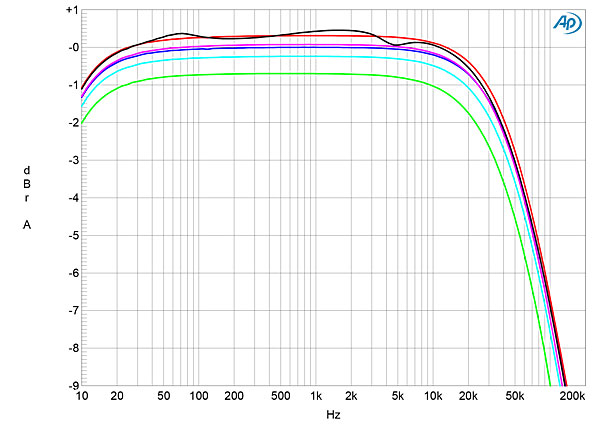

Channel separation via the line inputs (not shown) was okay, at 72dB in both directions below 2kHz, decreasing to 48dB, L–R, and 56dB, R–L, at 20kHz. The level of the Moonriver's noise floor dropped at lower settings of the volume control, but even with the control at its maximum, which is the setting I use for noise-floor analysis, supply-related spuriae at 60Hz and its harmonics remained at or below –90dB ref. 1W into 8 ohms (fig.3). The higher-order supply harmonics were around 10dB lower in level in the right channel (red trace) than the left (blue). The wideband, unweighted S/N ratio, taken with the input shorted to ground and the volume control set to its maximum, was 54.7dB, left, and 49.9dB, right, ref. 2.83V output into 8 ohms. Restricting the measurement bandwidth to the audible range improved the ratios to 75.3dB and 74.8dB, respectively, while switching an A-weighting filter into circuit improved the ratio in both channels to 77.8dB.
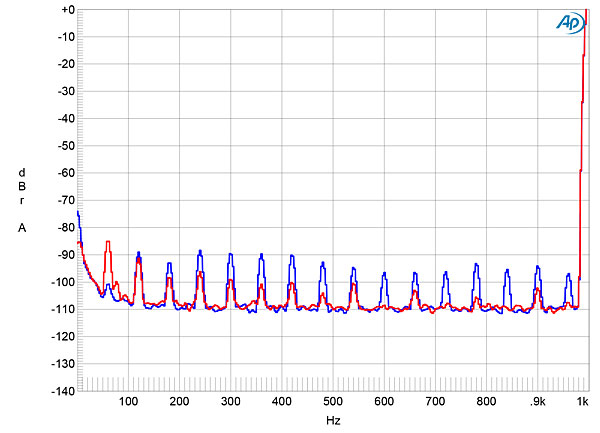
Fig.4 plots the percentage of THD+noise in the 404 Reference's speaker output vs power into 8 ohms. Though the 404 Reference's maximum power is specified as 50W into 8 ohms (17dBW), using our definition of clipping, which is when the output's percentage of THD+noise reaches 1%, fig.4 indicates that the amplifier clipped at 39.5Wpc into 8 ohms (14dBW). The Moonriver clipped at 60W into 4 ohms (14.8dBW, fig.5). (Both graphs were taken with both channels driven. The first sample's right channel behaved identically.)
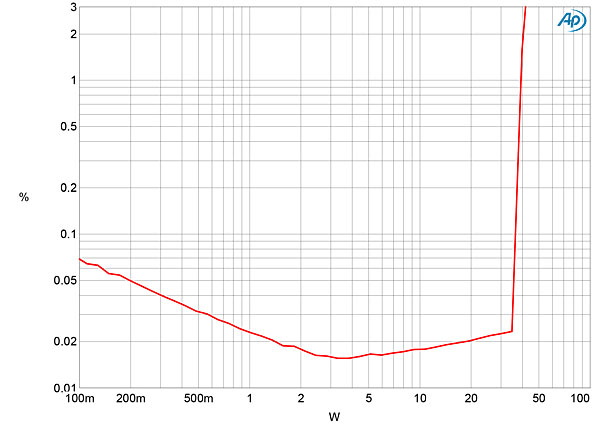
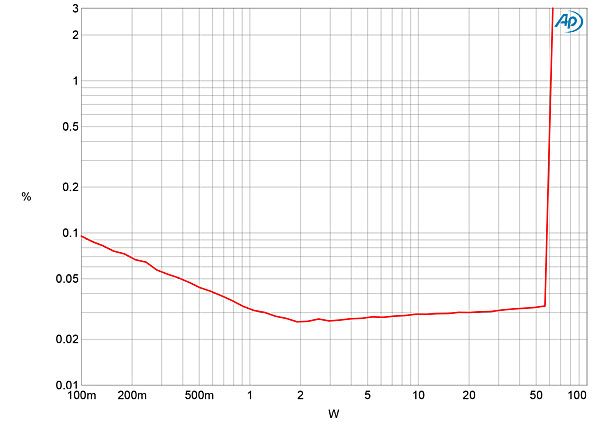
I measured how the 404 Reference's distortion changed with frequency at 12.67V output, which is equivalent to 20W into 8 ohms and 40W into 4 ohms. The THD+N percentage was low in the midrange and bass into both loads (fig.6) but rose in the top audio octaves, more in the right channel (red, magenta traces) than the left (blue, cyan). The distortion is predominantly the subjectively innocuous second harmonic (fig.7) with the third and higher harmonics lower in level, even into 4 ohms (fig.8). Even with the rise in distortion at the top of the audioband, intermodulation distortion was low (fig.9), the difference product at 1kHz resulting from equal-level tones at 19kHz and 20kHz at high power into 4 ohms lying just below –80dB (0.01%).


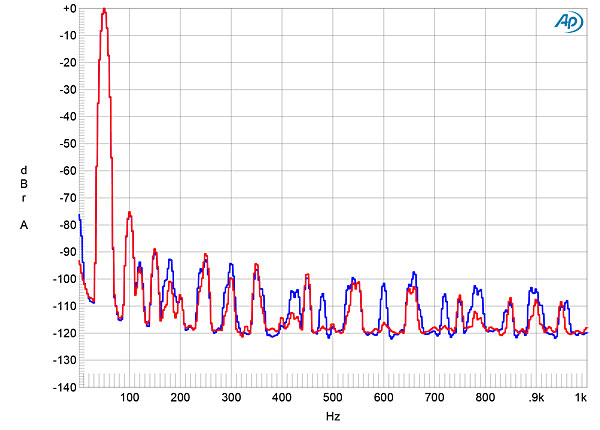
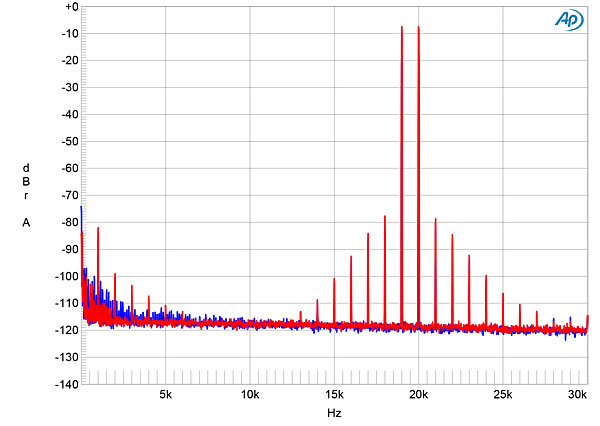
The first sample included the optional USB digital module. I didn't test this, however, as it uses an AKM DAC chip that is no longer available due to a disastrous fire at the Japanese factory in late October 2020. (Moonriver is redesigning this module to use a chip from another manufacturer.) The digital module wasn't installed in the second sample of the amplifier. The 404 Reference's phono input offers moving magnet and moving coil modes, these selectable with internal DIP switches; however, the second sample of the 404 Reference had not been fitted with the phono module: This input behaved identically to the line inputs.
The Moonriver 404 Reference's measured performance had some good points: the low level of power-supply spuriae and the distortion signature, which is primarily the subjectively benign second harmonic without this being accompanied by excessive levels of intermodulation distortion. However, the amplifier does not meet its specified powers. I was also bothered by the high level of ultrasonic noise from the preamplifier outputs.—John Atkinson

That is a very attractive piece of gear, a bit of vintage Sansui.

From JVS' conclusion: "...that makes it difficult for me to proclaim the Moonriver 404 Reference integrated amplifier a new benchmark for sonic excellence in an integrated costing $5000 or less. But I'm tempted to anyway, because it does justice to complex and demanding recordings and it sounds tonally spot on, well balanced, clear, and musical.
For some of you, the Moonriver 404 integrated may be the longed-for component, just waitin' round the bend, that transports you to audio nirvana. With dutiful attention to setup and component matching, the Moonriver Model 404 integrated amplifier can deliver Class A sound at a Class B price, and joyful listening."
Mid Fi?
How so?

Hi
Too true!
Like it or not, this is human weakness !
Jack L

JVS...The first three paragraphs of this article speak to the essence of the experience better than any description I've ever read. I've shown it to several people who have asked "What is it with sitting in the dark listening to music?" Thank you so much for putting into words what I have been unable to express but have felt strongly over my lifetime of listening.

my big takeaway from those first four paragraphs is that I shouldn't quit my day job

Interesting comments about Toscanini singing along with his orchestra. His intense shouts of encouragement can be heard in his 1951 Verdi Requiem recording (in the Dies Irae), and he hums along briefly in the final section of his last studio recording of Strauss' Death and Transfiguration.

So, it doesn't meet its claimed power ratings and it doesn't measure that well in some respects. But it sounds WONderful, blissfully so. That could well be. I might like it myself. But at the same time, I'm skeptical of components that don't measure well, and probably won't buy them, insofar as my budget allows. I trust components that are well designed and meet their power requirements, have low noise and distortion, and nice square waves. Measurements, for me, tend to confirm, or disconfirm, what a reviewer is saying, and certain aspects of measured performance, for me, correlate importantly with what I like. (I like 21 bits of resolution a lot more than 18, for example.) But all this also points up a fact which JVS and all of us need to face, which is that enjoyment of music isn't necessarily correlated, ever, with sound quality. I enjoyed listening to California Dreaming or Cast Your Fate to the Wind as a kid on transistor radio in the '60s as much as I now enjoy Strauss' Four Last Songs on my fine stereo or headphones. Maybe knowing that the amplifier wasn't that expensive or powerful freed our reviewer from worrying about critical listening so much and freed him to simply enjoy the music. Or maybe it does what poorly measuring tube amps do -- transport us back to the days of distorted sound in our childhood when we really enjoyed music.

.....quoted Moon River founder.
Hi
Agreed to what you state: "it doesn't meet its claimed power ratings and it doesn't measure that well in some respects. "
Stereophile measured the amp clipped at 39.5W@8ohm load & its lowest distortion 0.016% at 3.5Wrms output power.
However good it may sound, this amp was measured far inferior to what the manufacturer claimed.
I can only suggest that Sterophile lab measurement used a simulated loudspeaker load vs this Moon River amp was measured with a 8ohm resistance dummy load.
Surely simulated loudspeaker load reflected the more realistic performance of the amp.
Jack L

........ with sound quality." quoted Long-time listener.
Yea, "One day when we were young"! I would call it 'evolution'.
Decades back, when we were junior school kids, AM radio was our only entertainment centre to enjoy free music off the air at home. How nice!
Todate, science evolution has brought us hi-tech audio which demands "critical listening" to justify the high costs involved.
That said, many musicians, & music industry personnel still enjoy bigtime music from Lo-Fi audio. Apparently, they don't think they need hi-end audio at all !
My elder son is a live example. He does not own any hifi & enjoys music-to-go from his iPhone earbuds & from labtop mini speakers at home. Mind you, he earned his first class honour of Classical Piano in theory & practice from our city's Royal Conservatory of Music when he was only 18 before entering university. He is still a perfect pitch !!
Listening is believing
Jack L

Some companies have to learn the hard way that if something is to be shipped, it must be able to be tossed without incurring damage.
It is regrettable that there seems to be no obvious way to buy Shockwatch indicators in small quantities. Someone should choose to fix this.
USM Haller uses Shockwatch indicators on at least some of its furniture shipments. I do not know whether Herman Miller does, but they can tell just how many feet a crate was dropped onto a loading dock, by lookng at the damage. I once described damage to a chair to a Herman Miller support rep, and he said, "That requires a minimum drop of fifteen feet to a hard surface".
https://www.uline.com/Product/Detail/S-5158/Damage-Indicators/Shockwatch-Indicators-50G?keywords=5158
Shockwatch® Indicators - 50G

......without incurring damage." quoted C. Flynn.
Ideally it SHOULD be so. But this is not an ideal world, my friend.
Ask any electric appliance store managers if any damage on delivery of fridges or stoves, let alone small household items, you will be surprised so much claims of transit damages from customers daily !!
If you take a look inside the Moonriver deceiver, you would be surprised to see how vulnerable is the entire component layout to transit damage.
The most bulky & heaviest item: the toroidal power transformer is mounted on the SAME circuit board of the entire amp !!!!
The flimsy PCB is NOT designed to hold such heavy load !! The power transformer should have been installed directly onto to the rigid baseplate of the receiever. Period. Totally separated from the main PCB !!!
It is therefore the receiver makers design gross error in the first place. Damage could be done even the courier dropped off the box at the doorway not so gently for the receipient to sign off.
It is the physical layout design error to warrant for undue transit damage !!
Jack L

... a few hundred dollars to buy a basic oscilloscope so that he (and we) could know if a relatively low-powered amplifier, such as this 404, is ever being driven into peak clipping when driving his Wilson speakers?
Also, should the simulated loudspeaker load, that JA1 uses for his tests, perhaps be revised to more closely emulate the impedance of a speaker such as the Wilson Alexia?
Up through the midrange, the impedance of the existing simulated load never drops below 6Ω, while the impedance of the Alexia approaches 2Ω at several points.

https://www.warnerclassics.com/release/brahms-violin-concerto-3

JVS
I've listened to the Moonriver and agree with you,
it is a lovely and powerful amplifier. As a result, I am considering purchasing the amp. However, since most of my
listening is via streamer. I am wondering if using
a Roon Nucleus, as the streamer, and connecting the Roon
via a USB cable to the onboard dac is a good idea? Or
would suggest a different approach. Thanks